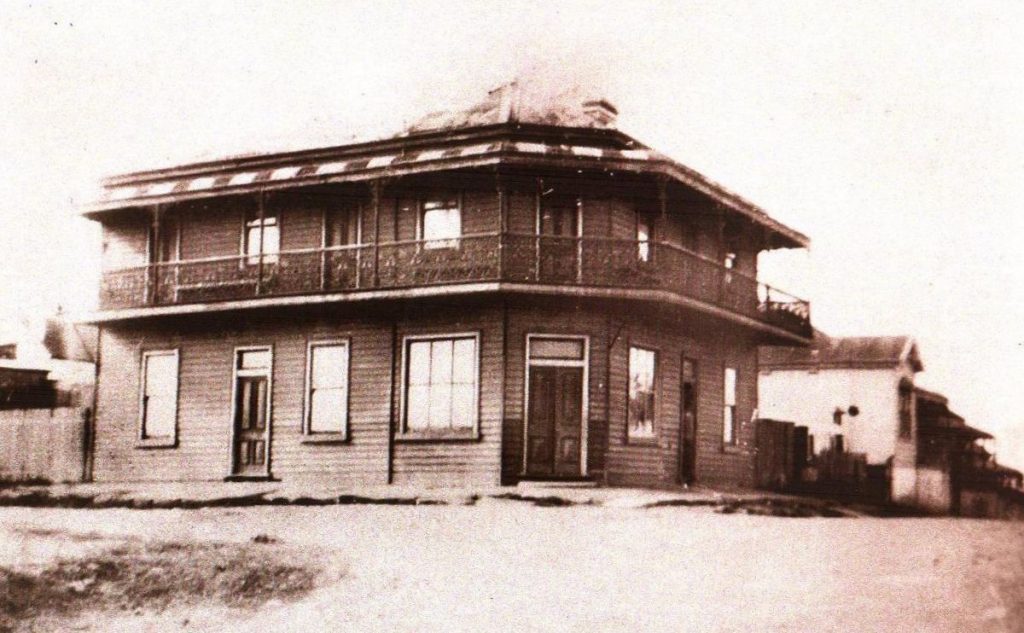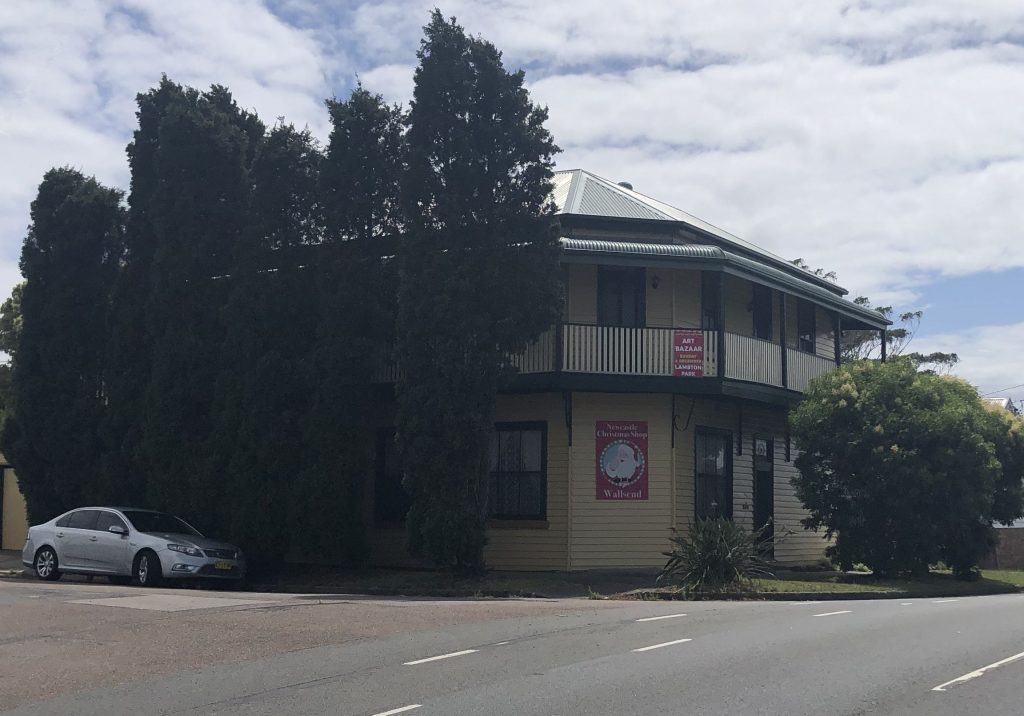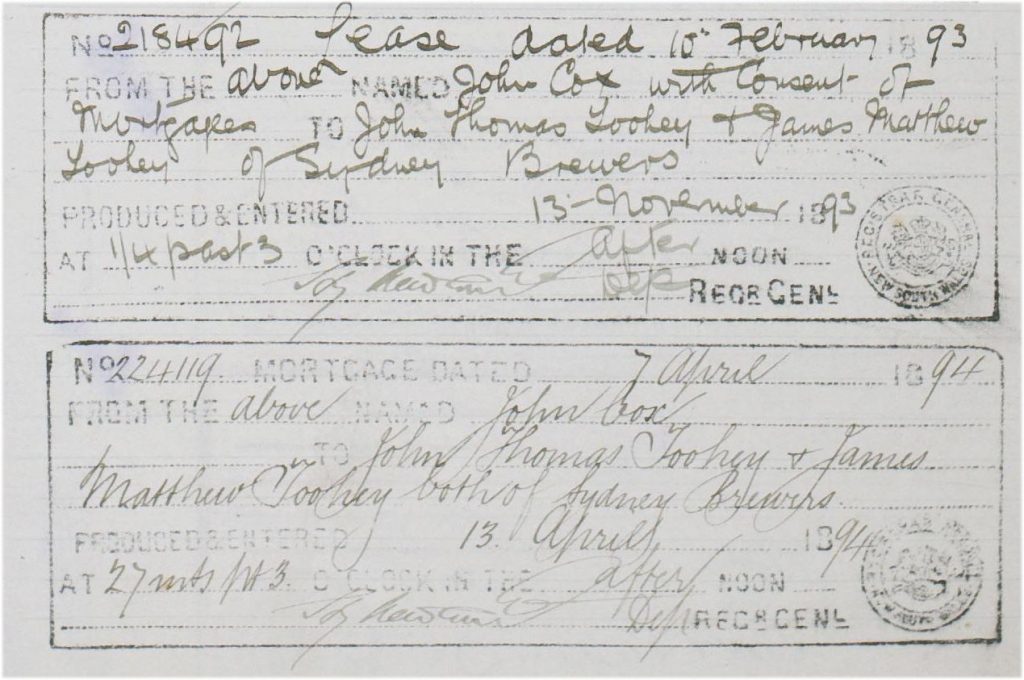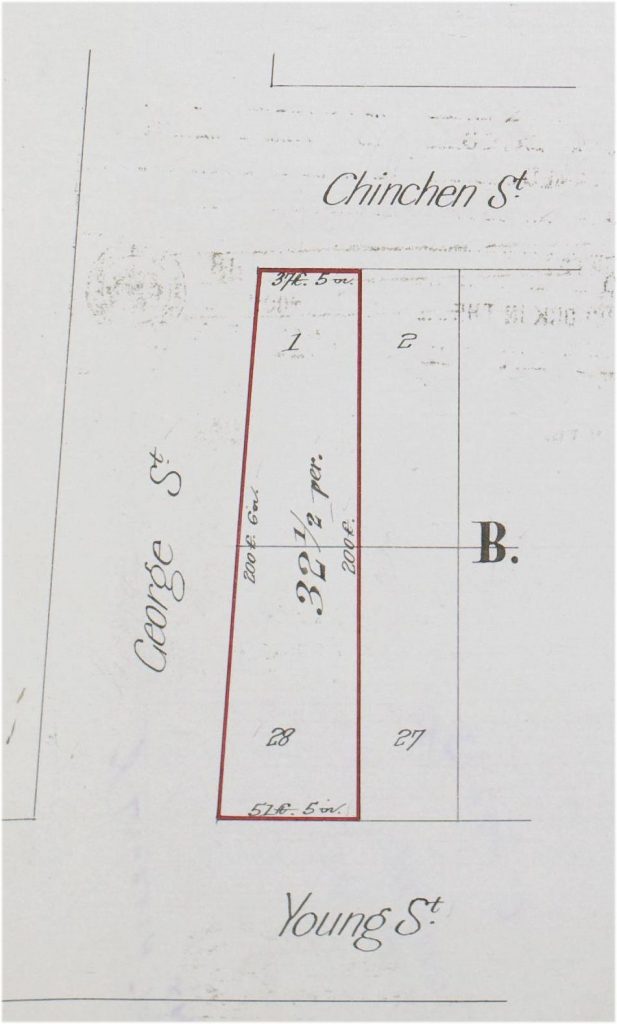How many hotels does a mining township need? In the boom years of the 19th century the answer was ‘lots’. But after World War 1 the answer was ‘less’, for these were the years of the Licenses Reduction Board. The Reservoir Hotel on Newcastle Road at Lambton was one of the casualties of the board’s deliberations 100 years ago.
In 1864 Robert Cairns opened the “Lambton Arms” in Pearson St, the first of many hotels in the town. As the population grew, so did the number of hotels, reaching a peak of 16 in 1881. In 1888, John Cox commissioned a new hotel on the main road opposite the town’s recently installed water reservoir. The two-storey weatherboard building, designed by architects Bennett and Yeomans, contained sixteen rooms and a cellar, and opened for business in July 1888 with Jacob Dent as the first licensee.
Fourteen publicans ran the hotel in the following 33 years, until the Licenses Reduction Board brought an end. The board was born out of the Prohibition movement, but not in the way you might expect. In the face of growing activism from groups wanting to ban all alcohol, a citizen’s association was formed in 1919 to “oppose the extreme and ruinous legislation proposed by prohibitionists”, and to instead promote a policy of “moderation and temperance”.
In December 1919 the NSW parliament passed a bill that instituted the Licenses Reduction Board. Their purpose was to reduce the number of licensed premises to a maximum based on population, by closing hotels with a history of liquor act convictions, or those in poor physical condition. Compensation was to be paid to owners and licensees.
During 1920 the board inspected 152 hotels in the Newcastle area, and on 28 January 1921 announced its decision that 23 licenses were to be revoked, including the Reservoir Hotel at Lambton. In August 1921 John Baptist Beisler, the final publican of the hotel, closed the bar for the last time. The building has been a private residence since that day.


The article above was first published in the January 2021 edition of The Local.
Additional Information
the Hotel
A report in the Newcastle Morning Herald and Miners’ Advocate on 31 May 1888 provides details of the newly opened Reservoir Hotel …
The completion of the new hotel built to the order of Mr. J. Cox, of the Yacht Club Hotel, Newcastle, by Mr. George Froome, of Wallsend, Messrs. Bennett and Yeomans being the architects, was marked by Mr. Cox inviting some of his Newcastle and district friends to inspect the building, and after wards do the usual honours in favour of Mr. Jacob Dent, of Lambton, who will be the lessee on opening. The hotel is splendidly situated, near the reservoir on the Lambton Wallsend-road, commanding a splendid view of at least three fourths of the district. It is a weather-board building, containing sixteen rooms and commodious cellar, out-houses, stable, &c., being built on an entirely improved plan, which reflects great credit on the architects and builder. All the rooms are well ventilated and lighted, a splendid balcony runs around half of the building with a frontage to George-street and the main road; in fact all that can be desired, in the way of an hotel in the strictest sense of the word is to be found in the building.

There were a total of 14 licensees of the Reservoir Hotel in its 33 year history.
- Jacob Dent (1888 to 1892)
- William Rutherford (1893 to 1897)
- John Cox (1898 to 1900)
- Ellen Jane Cox, widow of John Cox (1900 to June 1902)
- William Newell (June 1902 to June 1903)
- Thomas Weaver (June 1903 to May 1904)
- Joseph Brindley (May 1904 to 1905)
- William H North (1906 to 1910)
- Thomas Owens (1911 to 1912)
- B D Holloway (1913)
- Thomas Mordue (1913 to March 1917)
- John McKenzie (March 1917 to 1918)
- Mary Etta Graham (1919 to 1920)
- John Baptist Beisler (1921)
It is important to remember when researching old hotels, that the licensee of the hotel is not necessarily the same as the person who owns the land and hotel building. Regarding the ownership of the Reservoir Hotel, Volume-Folio 806-208 in the Historical Land Records Viewer shows that John Cox purchased the land in August 1886, being Lots 1 and 28 of Section B

Volume-Folio 806-208 shows that the property was then leased to “John Thomas Toohey and James Matthew Toohey of Sydney, Brewers”, in February 1893.

John Cox owned the land until his death in 1900, and then his widow, Ellen Jane Cox sold the land to “Castlemaine Brewery and Wood Brothers and Company, Newcastle” in June 1902. They retained ownership of the property for the remainder of the working life of the hotel.

John Baptist Beisler, the final licensee of the Reservoir Hotel, held the license for less than a year. In 1930 Beisler obtained the license of the Marquis of Lorne Hotel in Morehead St, and he and his wife and his family held the licence of that hotel for an impressive 46 years, until the family sold the business in 1976.
The Licenses Reduction Board
In Sydney in March 1919, a the Citizens’ Rights and Liquor Reform Association was formed, to advocate a middle ground between ‘prohibition’ and ‘business as usual’ in the alcohol trade. The report in The Sun newspaper on 20 March 1919 explained the association’s objectives, one of which was the establishment of a Licenses Reduction Board..
A number of Sydney citizens believe that liquor reform is one of the most vital problems before the people of Australia at this time. There have hitherto been only two alternatives — continuance of the liquor traffic and its palpable abuses or absolute prohibition. These men also believe that the real solution lies in neither of these extremes. They prefer the means of moderation and temperance … the new organisation will “oppose the extreme and ruinous legislation proposed by prohibitionists, aided and abetted by the money and the professional, agitators of the American Anti-Saloon League, who, by an impertinence and arrogance unparalleled in Australian history, have injected themselves and their theories into an arena hitherto regarded as inviolably domestic.” On the other hand, the association will use all its power to bring about real temperance reform.
Some of its objectives are: — The elimination of unnecessary and undesirable hotels through a Licenses Reduction Board; cancellation of the licenses of unscrupulous licensees and their permanent disqualification; making all hotels actually and in fact places of public accommodation and reputable social entertainment; and reduction of alcoholic strength of liquors.
There was much debate throughout 1919 in the papers and in Parliament about how the Liquor Act should be reformed. Finally, in the early hours of Wednesday morning 18 December 1919, the Parliament passed the final stage of the “Liquor (Amendment) Act 1919”.
The Act covered include a number of reforms, including …
- Establishment of a Licenses Reduction Board
- No new liquor or publican’s licenses to be granted
- Reduce the number of publican’s licenses over a period of three years
- by a number not exceeding one fourth
- to a maximum number based on a formula involving the size of the electorate.
- The board to hold hearings to assess which licensed premises might be closed.
- Premises to consider for delicensing to include those where
- there have been convictions for selling alcohol to minors, selling to intoxicated persons, gaming or prostitution offences
- “the business in the premises is so badly conducted as to be a serious inconvenience to persons requiring accommodation, or a nuisance to the neighbours, or insufficiently provided with proper sanitary conveniences”
- Assess the amount of compensation to be paid to owners and licenses
In Newcastle, “the board carefully inspected each of the 152 licensed premises in the electorate” and in January 1921 announced their decision that the following 23 hotels were to have their license removed.
- Selbourne Hotel, Newcastle
- Royal Crown Hotel, Adamstown
- Strand Hotel, Newcastle
- Railway Hotel, West Newcastle
- Federal Hotel, Stockton
- Carrington Hotel, Wallsend-Plattsburg
- Grapes Inn Hotel, Wallsend-Plattsburg
- Imperial Hotel, Wallsend-Plattsburg
- Northumberland Hotel, Wallsend-Plattsburg
- Miners’ Arms Hotel, Young Wallsend (Edgeworth)
- Bonnie Doon Hotel, Minmi
- All Nations’ Hotel, Newcastle
- Masonic Hotel, Newcastle
- Newcastle Hotel, Newcastle
- Australian Hotel, Newcastle
- Mafeking Hotel, Newcastle
- Miners’ Arms Hotel, Newcastle
- Clyde Hotel, Carrington
- Central Hotel, Lambton
- Reservoir Hotel, Lambton
- Royal Hotel, Wallsend
- Railway Hotel, Minmi
- Tattersalls Hotel, West Wallsend
The licenses weren’t revoked immediately, but simply not renewed at the expiration of the current annual license. The board also determined compensation to be paid, and announced their decision in May 1921. For the Reservoir Hotel in Lambton, compensation was decided to be “£1450 to owner, £190 licensee; total, £1640.”
Other Lambton hotels
In the article I wrote that the number of hotels in Lambton reached a peak of 16 in 1881. The graphic below charts the evolution of hotels in Lambton from 1864 to the present. In compiling the list I am including hotels that were in the Lambton Municipality, so that includes hotels that were in Dark Creek, that is the area of Jesmond east of the inner city bypass.
Click on the image below to get a larger view, or see my comprehensive list of the hotels in Lambton.

Newspaper articles
| Article Date Event Date | Notes |
|---|---|
| 21 Dec 1887 | Application by Jacob Dent for a "Conditional Publican's License for premises proposed to be erected at the intersection of George and Young streets, Lambton, to be known by the sign of Dent's Reservoir Hotel." |
| 31 May 1888 30 May 1888 | Opening of "Dent's Reservoir Hotel", on the corner of George and Young streets, opposite the reservoir. |
| 5 Jul 1888 | Confirmation of the conditional license for Jacob Dent's Reservoir Hotel, Lanbton Heights. |
| 29 Aug 1888 | Advertisement for the newly opened "Dent's Reservoir Hotel". |
| 20 Mar 1919 | Formation of the Citizens' Rights and Liquor Reform Association, to advocate a middle ground between 'prohibition' and 'business as usual' in the alcohol trade. |
| 18 Dec 1919 17 Dec 1919 | In the early hours of Wednesday morning the final stage of the Liquor Amendment Act was adopted. |
| 18 Jan 1921 17 Jan 1921 | At the Licenses Reduction Board hearing for the Reservoir Hotel ... "Inspector Cook produced certificates of two convictions, one in May, 1919, and the other in October, 1919. Sergeant Harrison said the hotel was an old weatherboard building in a fair state of repair. Four bedrooms were available to the public. The conduct was good. Travellers did not use it a great deal, but it served a population of about 1000." |
| 29 Jan 1921 28 Jan 1921 | The Licenses Reduction Board delivers its report at the Newcastle Courthouse, announcing that 23 hotels in the Newcastle Electorate should be deprived of their licenses, including the Reservoir Hotel and Central Hotel in Lambton. |
| 28 May 1921 | Compensation awarded to 23 hotels closed by the Licenses Reduction Board in Newcastle electorate, including £1640 to the Reservoir Hotel owner and licensee. |
| 24 Aug 1921 | The Reservoir Hotel closes as a licensed premise. |

